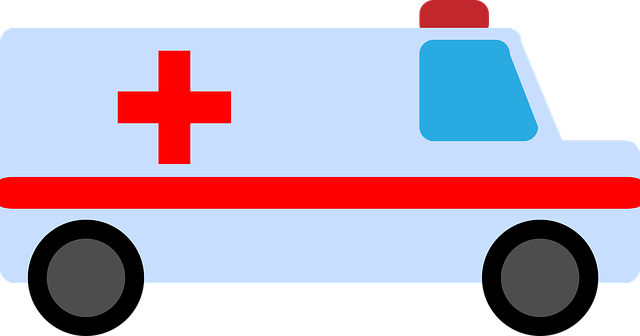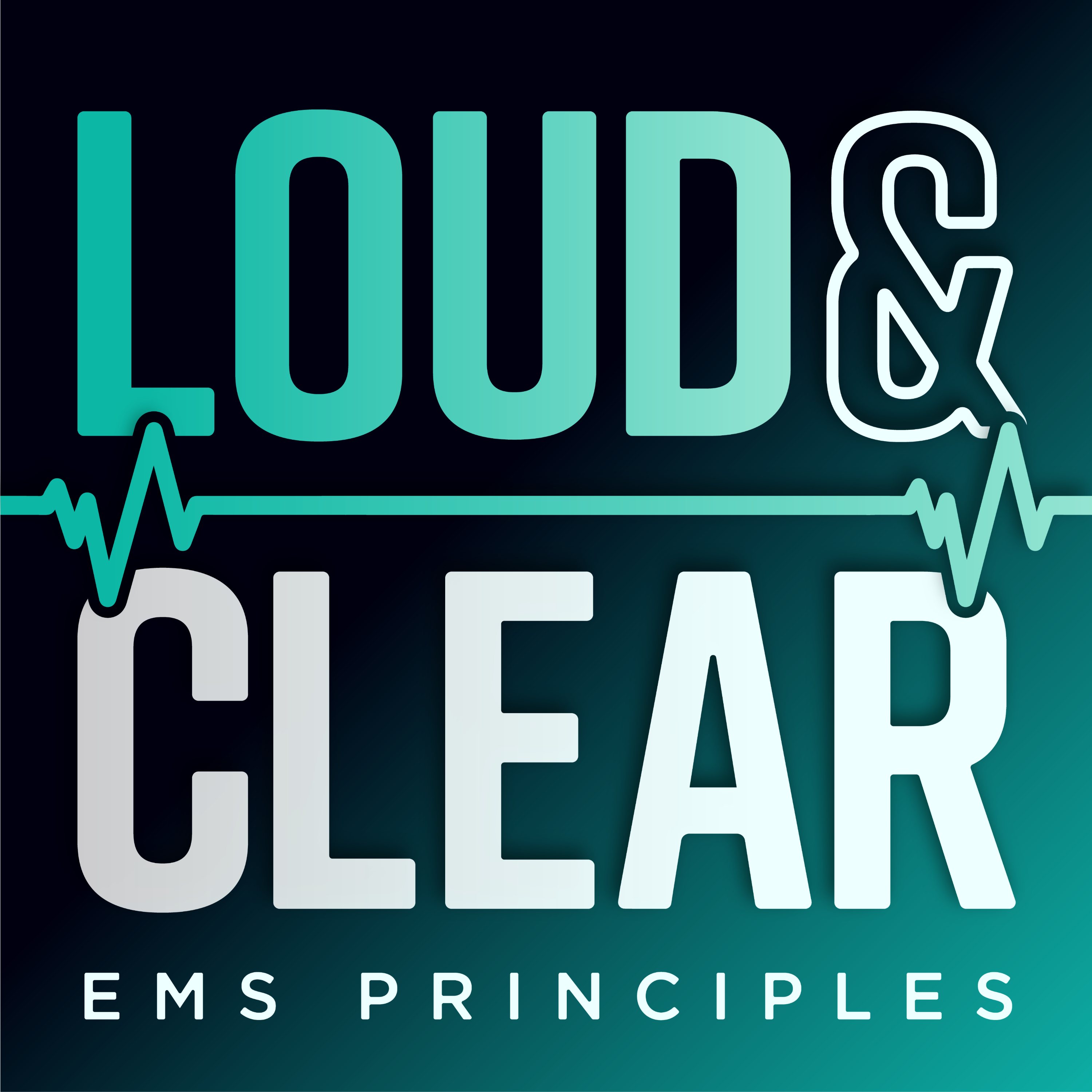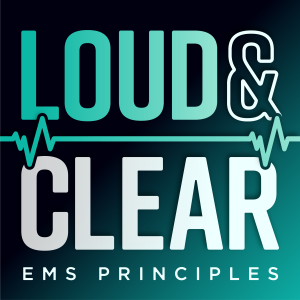

115.5K
Downloads
99
Episodes
Paramedic training is over, you’re in the front seat now. Whether day 1 or day 1,000 you can’t shake the fear you’re underprepared. You were taught to systematically decide if A... do B. But what if “A” wasn’t in the book? The truth is each emergency call is too unique to teach the right response to every situation. We need to go beyond algorithmic thinking and understand deeper principles, the WHY behind the algorithm. When every decision counts you want to rely on a framework that will guide you when things don’t make sense. Loud & Clear: EMS Guiding Principles is your resource to build that framework. Through discussions with experts, review of evidence-based best practices, and real-world case studies we teach you one step past what you learned in paramedic school. But all of this advanced education is connected back to the guiding principles that answer the question- “at the end of the day, what actually matters to the patient I have in front of me?” Our mission is to elevate your practice and help you improve patient outcomes in every emergency situation. You may not feel ready, you may not feel like you know enough, but by understanding the guiding principles of emergency medicine you can become an expert EMS clinician. Because what you do matters. Loud & Clear: EMS Guiding Principles is an EMS Cast LLC production
Episodes

Saturday Jun 15, 2024
Mushrooms: The Perils and Pleasures with Toxicologist Dr. Nik Matsler
Saturday Jun 15, 2024
Saturday Jun 15, 2024
In this episode, we delve into the fascinating and often perilous world of mushrooms. Join us as we explore with Dr. Nik Matsler how these fungi can be a culinary delight, a source of psychedelic experiences, or a deadly hazard. We discuss the challenges of identifying mushrooms, even for experts, and why toxicologists rely on mycologists for accurate identification. We'll break down the different types of mushrooms—non-toxic edible varieties, toxic species, and psilocybin-containing "magic mushrooms." Learn the practical tips for EMS professionals on managing mushroom poisoning, including supportive care strategies and specific interventions for severe cases.
Enter to Win a FREE Pair of Frontline Optics Sunglasses
EMScast15 for 15% Off Frontline Optics Sunglasses
Episode Blog Post- The Perils and Pleasures of Mushrooms

Friday May 31, 2024
Electrical Injuries and Lightning strikes
Friday May 31, 2024
Friday May 31, 2024
Derek Miller, outreach coordinator for the UNC JC Burn Center, joins us again to explore electrical injuries and lightning strikes. We discuss the various types of electrical injuries, the mechanisms behind these injuries, and the essential steps EMS providers must take to ensure their safety and provide effective patient care. Through real-life case studies and expert insights, this episode delves into the complexities of managing electrical burn patients, the importance of immediate interventions, and the potential long-term sequelae of such injuries. Tune in for practical advice and essential knowledge to enhance your skills in handling electrical emergencies.
Enter to Win a FREE Pair of Frontline Optics Sunglasses
EMScast15 for 15% Off Frontline Optics Sunglasses
Blog Post- Electrical Injuries and Lightning Strikes
Here are some additional resources:
Electrical Injuries Overview- Nice overview, though not limited to EMS specifically. The references list at end is also a good jumping off spot for those wanting more.
Photo examples- Variety of pictures
As mentioned at the end, fireworks safety- https://www.safefireworksnc.com/

Wednesday May 15, 2024
Stroke Care on the Streets, What Actually Matters? Bridging Research and Real-World EMS
Wednesday May 15, 2024
Wednesday May 15, 2024
Explore the nuances of stroke assessments, the challenges EMS professionals face in the field, and the impact of prehospital interventions on patient outcomes. Coco Wham, a former paramedic who's transitioned to a physician, and Dr. Layne Dylla, an associate professor of emergency medicine join us to dive into their ongoing research efforts aimed at defining what matters in prehospital stroke care and refining stroke response protocols. Hear firsthand how evidence-based practices are developed from the ground up in EMS settings. This episode is packed with valuable information to enhance your practice and understanding of stroke care in prehospital environments.
Enter to Win a FREE Pair of Frontline Optics Sunglasses
EMScast15 for 15% Off Frontline Optics Sunglasses
Blog Post- Stroke Care on the Streets

Wednesday May 01, 2024
Wednesday May 01, 2024
This is Part 2. Derek, an experienced clinician in burn care, joins us to delve into the intricacies and challenges of treating burn patients. This discussion provides valuable insights into the unique aspects of burn injuries, the importance of a comprehensive assessment, and the latest trends in burn treatment.
Enter to Win a FREE Pair of Frontline Optics Sunglasses
EMScast15 for 15% Off Frontline Optics Sunglasses
Blog post- The Critically Burned Patient
Key Topics Covered
-
Complexity of Burn Injuries: Derek begins by explaining why burn patients require a unique approach compared to other trauma patients. He highlights the potential for burns to mask other critical injuries, underscoring the necessity of a thorough and trauma-informed initial assessment.
-
The 'Big Three' Considerations: The conversation shifts to what Derek refers to as the "big three" — polytrauma, airway loss, and inhalation injuries — which are crucial early considerations in burn care. He stresses the importance of recognizing these potentially life-threatening conditions alongside the burn injury itself.
-
Fluid Resuscitation: A significant portion of the discussion is dedicated to fluid resuscitation, a critical aspect of burn care. Derek talks about the Parkland formula for calculating fluid needs based on the total body surface area affected by burns but a better simpler method is-
- 500 ml/hr for an adult (<13 yo)
- 250 ml/hr for a young kid (6-13 yo)
- 125 ml/hr for a child (<5 yo)
-
Pain Management and Ethical Concerns: Derek addresses the ethical and practical aspects of pain management in burn victims. Effective pain control not only improves patient comfort but also aids in overall patient management and long term healing, making it a critical component of the initial response.
- Assessment Tools and Techniques: Various assessment tools such as the Rule of Nines and the Palmer Method are discussed. Derek explains their applications and limitations, emphasizing that while these tools are helpful for initial assessments, more detailed evaluations are typically conducted at specialized burn centers. A link from ABA that may be helpful: https://ameriburn.org/resources/burnreferral/ Includes brief overview of severity/depth (with diagrams, not pictures), Rule of Nines & Palmar Method, plus a link for ABA referral criteria.
Here is another great article for a deeper dive into pros & cons of different methods of estimating TBSA, although not exhaustive, per se.
Gretchen C., Burn size estimation: A remarkable history with clinical practice implications,Burns Open, Volume 8, Issue 2, 2024, Pages 47-52, ISSN 2468-9122
Evaluation and Optimization of the Wallace Rule of Nines for the Estimation of Total Body Surface Area in Obese and Nonobese Populations, The Journal of Emergency Medicine, Volume 65, Issue 4, 2023, Pages e320-e327. - Burn depth estimates: There are free diagrams out there, but for actual real wound pictures, very little is open-license. UpToDate has a decent starting place, with four pictures embedded, and likely accessible for most.
Other Scientific papers mentioned-
Burn resuscitation
First article is an overview of evolution of burn fluid resuscitation formulas & philosophy – although again, not exhaustive, per se.
Bacomo, F. K., & Chung, K. K. (2011). A primer on burn resuscitation. Journal of emergencies, trauma, and shock, 4(1), 109–113.
Next article underscores the risks of fluid creep. Starting too high, being reluctant to titrate down, and the fact that giving too much fluid can actually CAUSE an increased need for fluids (vicious cycle).
Chung KK, Wolf SE, Cancio LC, Alvarado R, Jones JA, McCorcle J, King BT, Barillo DJ, Renz EM, Blackbourne LH. Resuscitation of severely burned military casualties: fluid begets more fluid. J Trauma. 2009 Aug;67(2):231-7; discussion 237. doi: 10.1097/TA.0b013e3181ac68cf. PMID: 19667873.

Monday Apr 15, 2024
The Critically Burned Patient - Part 1
Monday Apr 15, 2024
Monday Apr 15, 2024
Derek, an experienced clinician in burn care, joins us to delve into the intricacies and challenges of treating burn patients. This discussion provides valuable insights into the unique aspects of burn injuries, the importance of a comprehensive assessment, and the latest trends in burn treatment.
Enter to Win a FREE Pair of Frontline Optics Sunglasses
EMScast15 for 15% Off Frontline Optics Sunglasses
**CORRECTION** In the summary at the end of the episode, the rule of 5's was inappropriately attributed to the pediatric population. Rule of Fives is meant for morbidly obese adults, not for kids. Lund-Browder is great tool for peds of different age ranges, though still doesn’t address body morphology (obese kids).
- Resource- Evaluation and Optimization of the Wallace Rule of Nines for the Estimation of Total Body Surface Area in Obese and Nonobese Populations, The Journal of Emergency Medicine, Volume 65, Issue 4, 2023, Pages e320-e327.
Blog post- The Critically Burned Patient
Key Topics Covered
-
Complexity of Burn Injuries: Derek begins by explaining why burn patients require a unique approach compared to other trauma patients. He highlights the potential for burns to mask other critical injuries, underscoring the necessity of a thorough and trauma-informed initial assessment.
-
The 'Big Three' Considerations: The conversation shifts to what Derek refers to as the "big three" — polytrauma, airway loss, and inhalation injuries — which are crucial early considerations in burn care. He stresses the importance of recognizing these potentially life-threatening conditions alongside the burn injury itself.
-
Fluid Resuscitation: A significant portion of the discussion is dedicated to fluid resuscitation, a critical aspect of burn care. Derek talks about the Parkland formula for calculating fluid needs based on the total body surface area affected by burns but notes that real-time adjustments are often necessary to avoid complications like over-resuscitation.
-
Pain Management and Ethical Concerns: Derek addresses the ethical and practical aspects of pain management in burn victims. Effective pain control not only improves patient comfort but also aids in overall patient management and long term healing, making it a critical component of the initial response.
- Assessment Tools and Techniques: Various assessment tools such as the Rule of Nines and the Palmer Method are discussed. Derek explains their applications and limitations, emphasizing that while these tools are helpful for initial assessments, more detailed evaluations are typically conducted at specialized burn centers. A link from ABA that may be helpful: https://ameriburn.org/resources/burnreferral/ Includes brief overview of severity/depth (with diagrams, not pictures), Rule of Nines & Palmar Method, plus a link for ABA referral criteria.
Here is another great article for a deeper dive into pros & cons of different methods of estimating TBSA, although not exhaustive, per se.
Gretchen C., Burn size estimation: A remarkable history with clinical practice implications,Burns Open, Volume 8, Issue 2, 2024, Pages 47-52, ISSN 2468-9122
- Burn depth estimates: Unfortunately, all of my favorite wound pictures for discussing 1st/2nd/3rd degree (superficial; both superficial & deep varieties of partial-thickness; full-thickness) are copyrighted, etc. There are free diagrams out there, but for actual real wound pictures, very little is open-license. UpToDate has a decent starting place, with four pictures embedded, and likely accessible for most.
Part 2: This is just part 1. Part 2 will be coming May 1st. We will simplify our approach to fluid resuscitation and dive into some nuances of burns and burn care.
Other Scientific papers mentioned-
Burn resuscitation
First article is an overview of evolution of burn fluid resuscitation formulas & philosophy – although again, not exhaustive, per se.
Bacomo, F. K., & Chung, K. K. (2011). A primer on burn resuscitation. Journal of emergencies, trauma, and shock, 4(1), 109–113.
Next article underscores the risks of fluid creep. Starting too high, being reluctant to titrate down, and the fact that giving too much fluid can actually CAUSE an increased need for fluids (vicious cycle).
Chung KK, Wolf SE, Cancio LC, Alvarado R, Jones JA, McCorcle J, King BT, Barillo DJ, Renz EM, Blackbourne LH. Resuscitation of severely burned military casualties: fluid begets more fluid. J Trauma. 2009 Aug;67(2):231-7; discussion 237. doi: 10.1097/TA.0b013e3181ac68cf. PMID: 19667873.

Tuesday Apr 02, 2024
Tuesday Apr 02, 2024
Which comes first epinephrine or airway? Out of hospital cardiac arrests involve critical and often complex decisions with sequence and timing of various procedure. What should you prioritize? We examine the nuances of advanced interventions, such as epinephrine and advanced airway placement, through the lens of recent studies, including a notable piece of research published recently in JAMA Network Open. Take a deep dive into the practicalities and philosophies that underpin prehospital cardiac arrest management, emphasizing the significance of basic life support skills and the role of advanced techniques in the pre-hospital setting. This episode engages, educates, and challenges EMS providers on the best practices that could potentially save lives during those critical first minutes of a cardiac emergency.
Enter to Win a FREE Pair of Frontline Optics Sunglasses
EMScast15 for 15% Off Frontline Optics Sunglasses
Articles-
Sequence of Epinephrine and Advanced Airway Placement After Out-of-Hospital Cardiac Arrest. JAMA Netw Open. 2024 Feb 5;7(2):e2356863. doi: 10.1001/jamanetworkopen.2023.56863.
Association of timing of epinephrine administration with outcomes in adults with out-of-hospital cardiac arrest. JAMA Netw Open. 2021;4(8):e2120176. doi:10.1001/jamanetworkopen.2021.20176
Epinephrine in Out of Hospital Cardiac Arrest: A Network Meta-analysis and Subgroup Analyses of Shockable and Nonshockable Rhythms. Chest. 2023 Aug;164(2):381-393. DOI: 10.1016/j.chest.2023.01.033
A Randomized Trial of Epinephrine in Out of Hospital Cardiac Arrest. (PARAMEDIC2) New Eng J Med. DOI: 10.1056/NEJMoa1806842
The influence of time to adrenaline administration in the Paramedic 2 randomised controlled trial. Intensive Care Med. 2020;46(3):426-436. doi:10.1007/s00134-019-05836-2

Friday Mar 15, 2024
Toxic Alcohols: Hidden Danger in Everyday Products and an Everyday Call
Friday Mar 15, 2024
Friday Mar 15, 2024
Toxicologist Dr. Nik Matsler teaches us the critical topic of toxic alcohol poisoning. The discussion sheds light on the dangers lurking in everyday household and industrial products that contain methanol, ethylene glycol, and isopropyl alcohol—substances not far removed from the alcohol found in beverages yet capable of causing severe, sometimes fatal, health issues.
Enter to Win a FREE Pair of Frontline Optics Sunglasses
EMScast15 for 15% Off Frontline Optics Sunglasses
Blog Post- Toxic Alcohols

Friday Mar 01, 2024
Friday Mar 01, 2024
In the high-stakes environment of prehospital medicine, the ability to perform a successful intubation on the first attempt is critical. The complexity of prehospital airway management cannot be understated, given the challenging conditions and the acuity of patients encountered. This episode delves into the strategies and techniques that can significantly improve the success rates of prehospital intubations, focusing on preparation, positioning, and the SALAD (Suction-Assisted Laryngoscopy and Airway Decontamination) method.
Enter to Win a FREE Pair of Frontline Optics Sunglasses
EMScast15 for 15% Off Frontline Optics Sunglasses
Blog post- Art of Laryngoscopy- The SALAD technique
Additional Podcast Episode- Mac 3 vs 4 podcast episode
Additional Resources-
Published Article on the SALAD Technique

Thursday Feb 15, 2024
The Truth about Mechanical CPR Devices: What the Data Really Says
Thursday Feb 15, 2024
Thursday Feb 15, 2024
Despite the allure of consistent compressions and reduced provider fatigue, does the data actually show that mechanical CPR devices improve outcomes? Tune in for a nuanced exploration of evidence-based practice in emergency medical services.
Enter to Win a FREE Pair of Frontline Optics Sunglasses
EMScast15 for 15% Off Frontline Optics Sunglasses
Blog Post- https://emspodcast.com/the-truth-about-mechanical-cpr-devices-what-the-data-really-says/
Original Article- https://www.ncbi.nlm.nih.gov/pmc/articles/PMC8328162/

Thursday Feb 01, 2024
Thursday Feb 01, 2024
Overcoming Fear in Neonatal Resuscitation: A Step-by-Step Guide
Enter to Win a FREE Pair of Frontline Optics Sunglasses
EMScast15 for 15% Off Frontline Optics Sunglasses
Blog post: Neonatal Resuscitation
Introduction:
Welcome to another episode of EMScast, where high-level education meets real-world emergency medical scenarios. Today, we have Dr. Avery MacKenzie, an ER physician from Southwest Colorado, joining us to discuss a topic that often induces stress – neonatal resuscitation. Dr. MacKenzie shares her experiences and insights into handling neonatal emergencies in rural settings.
Summary:
Dr. MacKenzie opens the episode by acknowledging the inherent fear associated with neonatal resuscitation, especially in rural emergency departments where one might be the sole provider. She emphasizes that despite the fear, the process is not hard, and providers already possess the necessary skills.
Key Takeaways:
1. **Facing the Fear:**
- Dr. MacKenzie encourages listeners to remember that while neonatal resuscitation may seem intimidating, the skills required are well within their expertise.
2. **Algorithm Overview:**
- The neonatal resuscitation algorithm is simplified into manageable steps, beginning with stimulating, warming, and drying the baby for the first 30 seconds.
- The next 30 seconds involve providing positive pressure ventilation to initiate breathing.
- Monitoring the heart rate is crucial, and if it remains below 100, providers should focus on correcting ventilation strategies.
3. **Initial Assessment:**
- Dr. MacKenzie introduces a simple three-question assessment for determining the need for resuscitation: term gestation, good muscle tone, and respiratory effort.
4. **Positive Pressure Ventilation:**
- The trigger for initiating positive pressure ventilation is if the heart rate is less than 100 or the baby is apneic or gasping.
- The emphasis is on adequate ventilation, and adjustments, such as using the MR. SOPA mnemonic, can be made to improve ventilation.
5. **Advanced Airway Considerations:**
- While advanced airways, such as intubation, are possible, Dr. MacKenzie highlights that pre-hospital protocols may favor supraglottic airways due to the challenging nature of neonatal intubation and the need to limit pauses in oxygenation and respiratory support.
6. **Continued Support:**
- The algorithm emphasizes a continuous loop of assessment, correction, and reassessment, with the goal of maintaining the baby's heart rate above 100.
Conclusion:
Dr. MacKenzie wraps up the episode by reassuring providers that familiarity with the neonatal resuscitation algorithm and periodic mental reviews can alleviate the fear associated with these critical situations. The key is to focus on what providers already know and apply those skills with confidence.